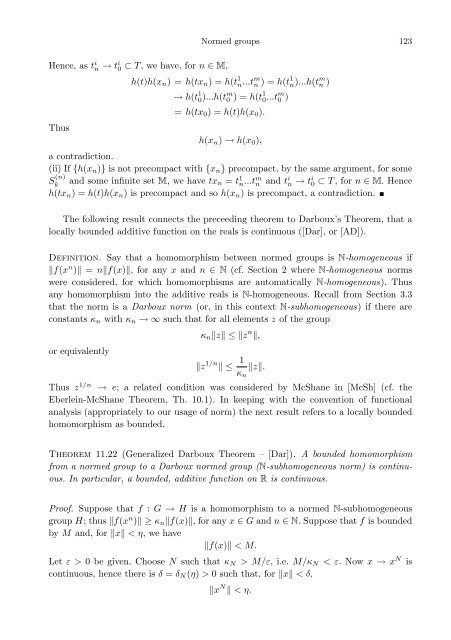Normed versus topological groups: Dichotomy and duality
Normed versus topological groups: Dichotomy and duality
Normed versus topological groups: Dichotomy and duality
Create successful ePaper yourself
Turn your PDF publications into a flip-book with our unique Google optimized e-Paper software.
<strong>Normed</strong> <strong>groups</strong> 123Hence, as t i n → t i 0 ⊂ T, we have, for n ∈ M,Thush(t)h(x n ) = h(tx n ) = h(t 1 n...t m n ) = h(t 1 n)...h(t m n )→ h(t 1 0)...h(t m 0 ) = h(t 1 0...t m 0 )= h(tx 0 ) = h(t)h(x 0 ).h(x n ) → h(x 0 ),a contradiction.(ii) If {h(x n )} is not precompact with {x n } precompact, by the same argument, for someS (n)k<strong>and</strong> some infinite set M, we have tx n = t 1 n...t m n <strong>and</strong> t i n → t i 0 ⊂ T , for n ∈ M. Henceh(tx n ) = h(t)h(x n ) is precompact <strong>and</strong> so h(x n ) is precompact, a contradiction.The following result connects the preceeding theorem to Darboux’s Theorem, that alocally bounded additive function on the reals is continuous ([Dar], or [AD]).Definition. Say that a homomorphism between normed <strong>groups</strong> is N-homogeneous if‖f(x n )‖ = n‖f(x)‖, for any x <strong>and</strong> n ∈ N (cf. Section 2 where N-homogeneous normswere considered, for which homomorphisms are automatically N-homogeneous). Thusany homomorphism into the additive reals is N-homogeneous. Recall from Section 3.3that the norm is a Darboux norm (or, in this context N-subhomogeneous) if there areconstants κ n with κ n → ∞ such that for all elements z of the groupor equivalentlyκ n ‖z‖ ≤ ‖z n ‖,‖z 1/n ‖ ≤ 1κ n‖z‖.Thus z 1/n → e; a related condition was considered by McShane in [McSh] (cf. theEberlein-McShane Theorem, Th. 10.1). In keeping with the convention of functionalanalysis (appropriately to our usage of norm) the next result refers to a locally boundedhomomorphism as bounded.Theorem 11.22 (Generalized Darboux Theorem – [Dar]). A bounded homomorphismfrom a normed group to a Darboux normed group (N-subhomogeneous norm) is continuous.In particular, a bounded, additive function on R is continuous.Proof. Suppose that f : G → H is a homomorphism to a normed N-subhomogeneousgroup H; thus ‖f(x n )‖ ≥ κ n ‖f(x)‖, for any x ∈ G <strong>and</strong> n ∈ N. Suppose that f is boundedby M <strong>and</strong>, for ‖x‖ < η, we have‖f(x)‖ < M.Let ε > 0 be given. Choose N such that κ N > M/ε, i.e. M/κ N < ε. Now x → x N iscontinuous, hence there is δ = δ N (η) > 0 such that, for ‖x‖ < δ,‖x N ‖ < η.
















